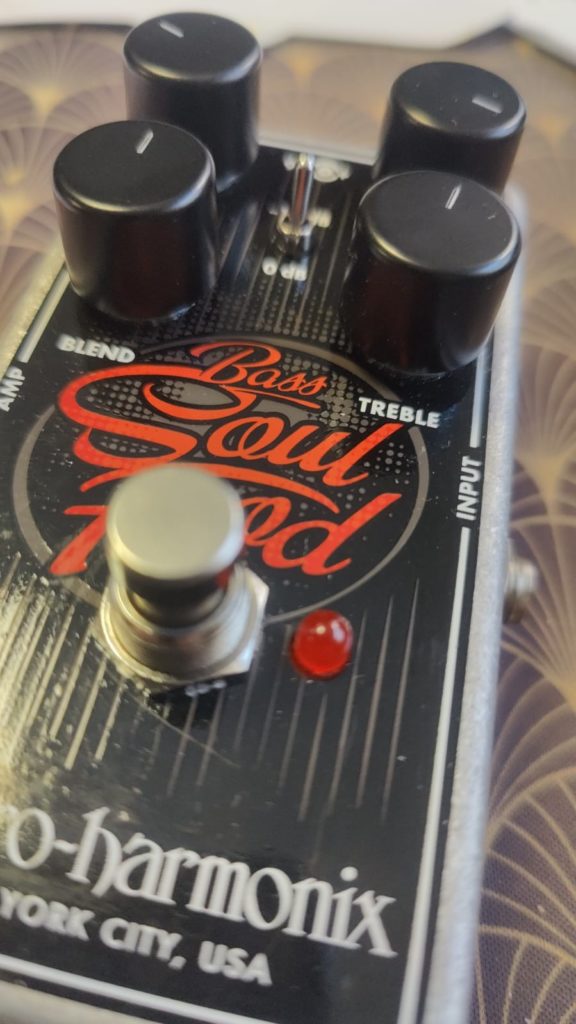Electro Harmonix (EHX) Soul Food Bass

This is the Electro Harmonix Soul Food Bass. As the name suggests, this is the bass version of the Soul Food. The Soul Food is the EHX version of the Klon, and apparently, the good people at Electro Harmonix understood the shortcomings of a Klon type circuit for the low end enjoyers, giving the bass version a makeover. Clearly visible, the Bass version has four knobs instead of three and also sports a switch. That switch controls a pad to reduce the input gain for active basses, and the fourth knob is a clean blend. The rest of the knobs are the typical gain / treble / level knobs.
The build quality is what most EHX pedals look and feel like. Solid, but I would not run it over with a car and expect it to work afterwards. This is not on par with what Origin or 3leaf makes, but neither is the price. Street price for the Soul Food Bass is just over a hundred Eurodollars and that includes a wall wart to power it.
Without further ado, I throw it on the pedalboard and see what a dedicated bass version of a Klon can do.

Before I get ahead of myself, let’s try and view this as a business situation, where strong, colorful words are heavily frowned upon.
I asked my artificial companion on how to properly critique in business context and was given a list. I will try and work through it as best I can.
When critiquing an effect pedal, you can focus on their work performance rather than their personal character. You can provide constructive feedback by:
- 1. Being clear and specific: Provide concrete examples of the issues and explain how the effect pedal’s actions impact the organization
- 2. Being timely: Address issues as soon as possible after they occur
- 3. Being positive: Include positive comments and praise to encourage improvement
- 4. Being collaborative: Encourage a two-way dialogue so the effect pedal can ask questions and share their perspective
- 5. Using “I” statements: Focus on the issue without making the feedback personal
- 6. Providing actionable advice: Offer solutions and support to help the effect pedal improve
- 7. Following up: Check in with the effect pedal to offer praise and support as they work to improve
Right after playing the EHX Soul Food Bass (2) I sat down to write my impressions.
I want to start on a good note (3). There is one setting on the pedal that I really liked, but it is somewhat of a hidden feature. When you unscrew the bottom and rummage around a bit, you will find a simple switch, which has two positions: Buffered and True Bypass. The default setting is buffered, at least this one came like that. When you flip that switch to true bypass (and put the lid back), you can push the foot switch so the LED indicator shows that the pedal is now in true bypass mode by turning the LED off. That is when you will get the absolute best sound, really enjoyable in my case.
The problems only start when the LED indicator lights up, because that is when the circuit is powered and active and my beautiful bass signal has to take a detour through the rotten entrails of this decomposing carcass the delusional and deranged demoniacs in the EHX lab dubbed a bass pedal.
It is a Klon alright. At least on paper. It does all the Klon things, like pushing your 1k range like there’s a contest of the Klones and whoever gets to +50dB first wins a box of NOS vintage germanium diodes, hand signed by Bill Finnegan.
It also neuters the low end somewhat fiercely. Think rusty hedge trimmers; Snip snip OUCH!
When you have the blend knob at 50% or higher (1), you need to ride the gain close to max to have something happen, and then the pedal mostly sounds like a vintage telephone filter. You’re feeling bandpassed with a massive boost in the upper mids. Not really sparkly up top. I don’t think of marble, I don’t think of pearls, bouncing off a polished metal surface. A good pedal creates this picture in my head. Instead of pearls bouncing off a polished metal sheet, this feels a bit like slate bouncing off tarmac. If you throw it hard enough, it will splinter and disintegrate, but the throw of the gain knob does not reach past mild drive settings, so it’s a half-hearted toss by a weak arm.
The weird bit is that the thing is so incredibly biting in your ears that no amount of dialing in clean sound really helps – unless you turn the knob all the way CCW to 100% dry – but even then, it sounds slightly muffled, as if some top end is cut off.
I (5) tried a lot to find something that works, but I (5) hit a wall here. The Klon fits perfectly in the “A terrible Idea beautifully executed” range.
Mr. Finnegan said “I’m gonna make the guitar amp sing with a beautiful rich and creamy sound, and to do that, I will hard clip a germanium diode”.
And then he proceeded and made it happen and how it works baffles me to this day, even after I have played many Klon based pedals. One thing I can say, though, is that the good ones really manage to bring something desirable to the table. Especially in my case, some of them can really be used to breathe a bit of fresh life into my well played flatwound strings, and at milder drive settings, they really bring in some secret sauce level of tonal beautification.
The Bass Soul Food sounds like it does nothing at all until you can hear some hard clipping going on that lacks in finesse and feels as subtle as firetruck.
And here lies the root of the problem. Most Klon type pedals – and by most I mean the good ones – don’t really couple nicely with low enders like me for the simple reason that their nature does not work with bass. It’s like burglar and beat cop; bloods and cribs; demons and exorcists; They won’t mix well.
However, if you tone it down some, you can get workable results. We both need to work on this. (4) I can lower my expectation of a big and fat tonal booty for a bit when the Klone presents something worthwhile at its milder settings and really makes the top end shine (6). As I said, this works with some of the Klones. The Wampler Tumnus and the Aluminum Falcon absolutely do some great work with the top end and add just a mild sizzle as an afterthought, smooth like velvet caressing your cheek. The Soul Food might try, but it’s more like 120 grit paper.
It really feels like someone heard that the Klon is a great pedal, downloaded the schematics and then slapped one together, using cheaper components that have been tested with the same values – without even listening to the output once, then getting the idea of making a bass version of this by slapping in a clean blend.
While this CAN work — you could, for example, cobble together a clean blend circuit and toss it in with a Zakk Wylde drive pedal that also emphasizes a range north of 700Hz. When you do that, however, you get a beautiful blend of dry and wet, so satisfyingly moist you bid a farewell to cleans.
It is a technique that, as I said, CAN work, but slapping a clean blend on an established guitar pedal is by no means a surefire way of creating a bass pedal.
The Bass Soul Food is a great example of that, if nothing else!
Ooh, nay! You cry! I spent a hard earned Benjamin on the acquisition of such a pedal! Now you say all it does is serve as a bad example!
Is my money lost?
Fear not, I (5) reply. For your money is maybe quite lost, but not entirely! Look into the box the Bass Soul Food came in. They were gracious enough (or laden with a heavy conscience) to include a 9V Wall Wart. You can use that to power a better pedal(6). Or sell it for ten bucks to recoup at least a tithe.